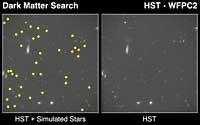The dark side of the universe

At first glance, one can think that there is something that has been sought for eighty years and that has not been found convinced that it is almost a matter of faith. However, there are very few who wonder, since the doubt about dark matter is, to some extent, doubting the basic laws of physics.
The existence of a matter not seen in the universe was first proposed in 1933 to explain the movement of some galaxies. In fact, if those galaxies had only visible mass, they had to move more slowly if the universal law of gravitation was correct. And the universal law of gravitation is not anything: Newton found it more than three hundred years ago and is one of the fundamental laws of physics. According to this law, the force of gravity is weakening as the distance between both bodies increases, specifically, the force is weakened according to the square of the distance, that is, the force of gravity is multiplied by four. Law and law are clear and broken formulas which express with the language of mathematics, elegant in one word, and which well describe reality. But those galaxies did not comply with the law. The mass of galaxies needed more to comply with the law, so they proposed that in these galaxies there was also material that was not seen: dark matter.
After these galaxies, they have observed in the universe more phenomena that do not comply with the basic laws of physics if there is no dark matter, and today they give for good that there is dark matter (and there is even dark energy in the universe, which would explain why the universe is expanding faster and faster). Physicists create and use a standard model to understand the universe based on Einstein's general relativity (including Newton's laws) and the existence of dark matter; and although they do not know what dark matter is, and have never detected it, measurements coincide with the model.

Therefore, dark matter is not at all a matter of faith: it exists, has mass and, as for gravity, it acts as what is seen, although in the rest we have no interaction that we can measure. For this majority, the challenge of the coming years is to detect dark matter. However, few have taken the opposite road. According to them, dark matter is an invention, it is anything, which is needed to explain the measures with a standard model and not a prediction based on the physics of particles. It can be said that, in a certain way, the majority is accused of wanting to adapt reality to theory using dark matter as a correcting factor. Therefore, they have abandoned dark matter and have begun to revise the basic laws of physics. They have elaborated theories that have been able to explain certain phenomena without using dark matter, but have not given conclusive results and for the moment they cannot compete with the standard model. In addition, they will have to work hard to compete, because they are trying to model a well-rooted model, and it is known what costs. Undoubtedly, it is an interesting debate.
Published in Berrian.
Buletina
Bidali zure helbide elektronikoa eta jaso asteroko buletina zure sarrera-ontzian











